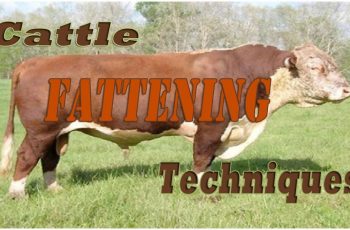How To Start Silage Making: A Guide For Goat Farmers In Nigeria
Silage making has become very important and necessary in goat farming due to the increase in demand and supply of goat meat and milk in Nigeria. Commercial goat farming in Nigeria is among the agribusinesses growing every year.

It is already obvious that the current supply of goat feed or fodder can no longer meet up with the demand. The buying of goat feed or fodder in the market has also become very much expensive, thus reducing the profit margin in goat farming business. It is very important and needful to grow green fodder crops to make the goat feed available at all times and reducing the cost of feeding the goat.
Read: Breeds of goat in Nigeria
Silage production is therefore the most viable option to the goat fodder or feed challenges facing goat farmers in Nigeria. Silage production involves the process of putting green fodder crops in container or environment that contains no air. Silage is a fermented green forage fodder that is stored in a silo.
Silage feed or fodder is fed to goats for better health, weight gain, and increased milk production. In this article, I will be listing the different green fodder crops that are best suited for silage making in Nigeria.
The Green Fodder Crops That Are Used For Silage Production
For the purpose of silage making, you must select the type of fodder crops to use. These particular green fodder crops must have quality sugar content, as well as good moisture content. This is because, during fermentation of the forage crops, the sugar is used up by microorganisms to produce lactic acid.
Fodder crops like maize, sugar cane, jowar, etc are best suited for silage making in Nigeria. Other legumes are also utilized during the silage making process. Depending on the size of your goat farm in Nigeria, you can cultivate these green fodder crops used for silage making in your farm environment.
Before harvesting your green fodder crops for silage making, you have to consider the following:
- Always harvest your green forage crops before they start bearing flowers, or at the flowering stage.
- You must be sure that the moisture content of the fodder crops that will be used for production or silage is not more than 75%
- When the moisture content is high, dry them in the sun in order to reduce the moisture content by 15% – 20%
- When using Maize (corn), Jowar, etc, you must chaff them to an inch size to prevent trapping of air and silage spillage.
- You can add water during packing silo if the green fodder crop is over dried.
The Benefits Of Silage Making Using Green Fodder Crops
In livestock farming in Nigeria, there are many advantages of silage making. These advantages include;
- It reduces the cost of feeding in goat farming business in Nigeria.
- It is highly needed in stall-fed goats.
- The silage can be stored for as long as two years.
- It is a good substitute during goat feed scarcity or when there is little or no forage crops for the goats to feed on.
- It improves the health of the goats by providing them with minerals and vitamins.
- When compared to the traditional forage crops, silage occupies less amount of space.
- Due to the presence of lactic acid, it is easily digestible by goats.
- It is less stressful when compared to traditional fodder cutting.
- When in excess, goat farmers can sell to their fellow farmers and make extra cash.
The Process Of Silage Making
There are two major methods involved in production of silage; they include the pit method and the tank method. The size of the pit or tank to be used for silage production is dependent on the number of the goats as well as the feed duration. If you plan to use the pit method, you should construct the pit on higher grounds. This is to prevent the inflow of water into the pit.
Read: How to start goat farming in Nigeria
The shape of the pit should be circular and not rectangular. This is to prevent the trapping of air within the edges of the rectangular pit during the filling and pressing of chaffed fodder crops. One of the keys for a successful silage making process is your ability to make the pit or tank air tight.

If you want to produce or make 7000 kg of silage, you will need a pit that has a depth, length, and width of 1 meter respectively.
Steps For Silage Making
The following steps below must be followed rigidly if you want to make quality silage for your goats.
- The first step is to decide whether to use pit of tank method of silage production. If you chose the pit method, the depth, width, and length of the pit will depend on the size of your goat farm and the feeding duration. To store 20 bags of fresh forage in a silo, you will need a pit that is 2 cubic meters in dimension, 10 meters of polythene sheets, and 32 liters of molasses.
- Before you fill the tanks or silos with fresh forage crops, you should clean and dry them properly.
- You should cover the sides and floor of the pit with polythene sheets to prevent the forage crops from coming in contact with soil in order to avoid air and moisture.
- Once you have covered the sides and floor of the pit with polythene, you can now fill it with the chaffed forage crops. While filling, you should spread the forage uniformly into a thin layer.
- One liter of molasses should be diluted with 3 liters of water and should be evenly sprinkled over the layer of the chopped forage. This is done to speed up the fermentation process, thereby preventing the forage crops from rotting.
- At this stage, you start pressing the forage inside the silo with your feet or any heavy equipment so as to remove as much air as possible. This is done to prevent the growth of fungi that will attack and destroy the forage in the silo pit.
- You should repeat this process of adding forage, sprinkling with diluted molasses, and pressing the fresh forage until the pit is filled. Once the pit is filled, cover it with polythene sheet to prevent water seeping, then dig a small water trench around the pit.
- You should cover the polythene with dry forage or soil in order to prevent the damage of the polythene by rain, rodents, and births.
- Allow the forage to remain in the pit for a period of 2 months.
- To collect the already prepared silage, you open the pit from the sloppy portion and collect as much silage fodder that will be enough for the day and then cover it back.
- You should feed the silage to the goats along with other fodders until they have adjusted to the taste of the silage. Well prepared silage lasts for a maximum period of two years.
Treatment Processes Involved In The Making Of Silage
You must treat the fodder in the pit or tank so that it will last long and still have good quality. Some of these treatment processes include;
- Addition of molasses: when legume crops are used for silage production, molasses should be added at the rate of 3.5% – 4% of green weight of silage in order to improve the quality and taste.
- Urea: when cereal forage crops like maize are used, its protein content can be improved by spraying 0.5% – 1% of urea on the fresh forage.
- Addition of lime: lime can be added to maize silage in order to improve the acid production capacity.
How You Can Identify A Quality Silage
Good quality silage always has a sweet and sour taste, and is brown in color. The ideal Ph for good quality silage is between 3.5 – 4.5. Bag quality silage is typically black in color and it has a rotten smell. There will be mould formation if there is presence of air in the pit.
There is no doubt that silage preparation has many advantages side from saving time, and money, it increases the profit margin in goat farming business in Nigeria.

